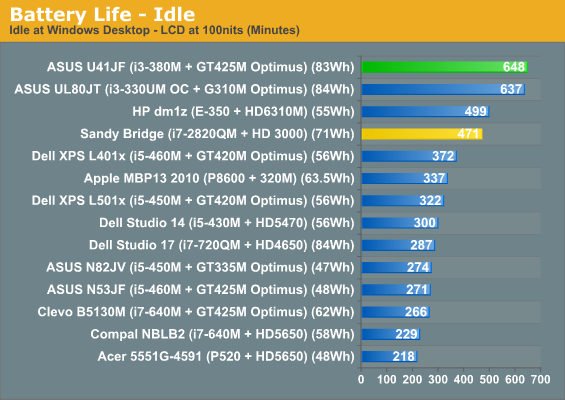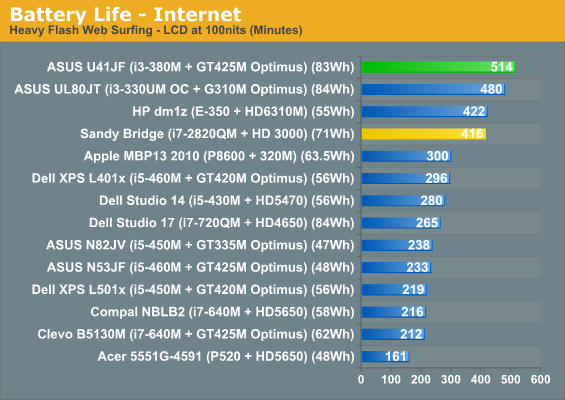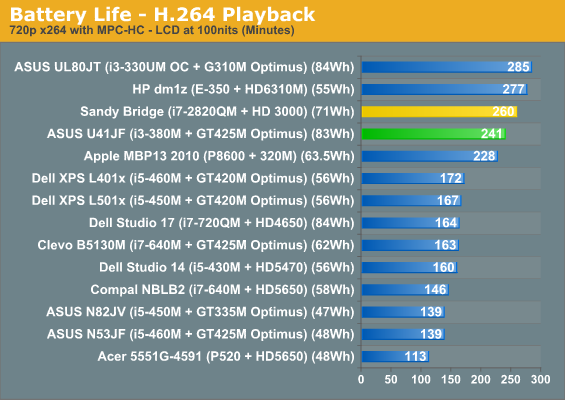ASUS U41JF: Arrandale's Not Dead Yet
by Jarred Walton on March 28, 2011 7:35 PM ESTBattery Life: Capacity Triumphs
There’s simply no beating a higher capacity battery, all other areas being equal. I do find it a bit funny that ASUS has relabeled their battery to be 83Wh now instead of 84Wh; technically it’s still 83.52Wh based on the simple (V*Ah) equation, but then you’re likely going to get a lot less than 83Wh out of it after a few months of use when it’s no longer running at 100%. Anyway, I don’t have much to add here on battery wear levels, as for some reason HWMonitor didn’t pick up the information for this particular laptop.
Looking at the laptop market as a whole, Apple is able to squeeze some amazing battery life out of their laptops with OSX, but install Windows 7 on them and they become merely average. ASUS has been one of the best options for battery life on Windows laptops ever since the debut of their UL series in 2009, and with the U41JF you can now get nearly all of the battery life with improved graphics performance when you want it. Also note that we tested with SHE (i.e. underclocking) enabled; if you choose to run at stock speeds, you’ll get about 10% less battery life.




When you can last over ten hours for basic work, or 8.5 hours of constant Internet surfing, you know you’re doing pretty well. The U41JF actually surpasses the ULV-based UL80JT in two of the three battery life results (with H.264 favoring the UL80JT). Compared to the older U30JC (not shown, but you can see the results in Mobile Bench), it also wins in the Idle and Internet tests, and the H.264 result is a lot closer than the UL80JT. The UL80VT is still our battery life champion, posting over 14 hours in the Idle test, but performance is clearly slower than the latest U- and UL-series laptops.
In keeping with recent tradition, I also tested several other areas of battery life. For an 83Wh battery, the U41JF manages to recharge pretty quickly, taking just over three hours (192 minutes) to go from completely drained to 100% charge. Power draw measured 37-57W while charging, with higher power draw when the battery was closer to dead. If ASUS is like other manufacturers, they have some smarts in their batteries so that they don’t overcharge some cells (and cause them to wear out faster), which would explain the drop in power draw as maximum capacity approached.
Gaming battery life as always is a bit of a stretch. You can run the CPU/GPU pretty much at AC performance levels, but not for all that long. Looping 3DMark03, the battery lasted 145 minutes, which would correlate to a less demanding game. 3DMark06 hits the CPU/GPU more, and battery life drops down to just 102 minutes (think of games like Crysis, Battlefield: Bad Company 2, Metro 2033, etc.) If you want to run the LCD at maximum brightness instead of 100 nits, we measured a rather high increase in power requirements of nearly 5W, so that’s one more item to consider. For most practical scenarios, though, the U41JF will provide an all-day computing experience with no need to find an outlet.











24 Comments
View All Comments
veri745 - Monday, March 28, 2011 - link
Now it's about time that they give the LCDs on these a resolution upgrade. I'd like to see atleast 1600x900jrocks84 - Monday, March 28, 2011 - link
I totally agree on higher resolution LCDs being needed! I haven't searched that hard, but the only two 13" laptops that I know of with a decent res are the Macbook Air and the Sony Vaio Z.lexluthermiester - Tuesday, March 29, 2011 - link
I have a Asus EEE 1201N with 1366x768 res. It beats out my old VIAO which was 1280x800. Now granted, the 1201n is only a dual-core Atom , but at a 12" screen and the fact it will some moderate gaming, it packs punch for it's size. Battery life is far better as well.Of course we are talking about a $400 price point with the 1201n. But I guess the point I'm trying to make is that if you look into what it is you want good things can be found. And honestly, the system in this review would tempt me greatly if the 1201n didn't already meet my needs.... but oh so tempting....
ImSpartacus - Tuesday, March 29, 2011 - link
I agree. I know many laptops will have to move to 16:9 for cost reasons, but why can't they just use 1600x900 as a baseline resolution?768 vertical pixels are unacceptable on anything but 11.6" displays.
blue_falcon - Monday, March 28, 2011 - link
The industry is trending towards industry standard resolutions (HD at the moment for most systems). I doubt you'll see a 1600x900 13.3 screen.Penti - Monday, March 28, 2011 - link
Sony still has some, 13.1" 1600x900 laptops that is. Let's see if they get updated to Sandy Bridge too. If you want it you can have it, even though most use standard displays.DLimmer - Monday, March 28, 2011 - link
As usual, excellent laptop review. I relied on http://www.anandtech.com/show/2862/dell-studio-14z... a couple years ago when I bought my wife's laptop, and it still does all she asks of it *and* lasts all day on one charge (with intermittent use).I also grabbed a Gateway P-6831 based on http://www.anandtech.com/show/2490.
Minor typos (first page third to last paragraph):
"One the flipside, ASUS’ Super Hybrid Engine (SHE)" -> *On* the flipside
(page 5, second paragraph from the bottom):
"and it doesn’t need 960 Steam" -> *Stream*
Thank you for providing objective and in-depth reviews we can use when selecting items to purchase.
ImSpartacus - Tuesday, March 29, 2011 - link
I almost bought a 14z instead of my MBP13'09. It was on the thicker side, but had a massive battery and a full voltage processor.Eventually, I had to have that big trackpad and disk drive.
In retrospect the decision was pretty murky.
DLimmer - Tuesday, March 29, 2011 - link
My wife misses the DVD drive occasionally, but we have an external. It's most annoying when you install some software that requires the disc be in the computer to run. Only other time is when she wants to rip a new CD she's bought.All-in-all, giving up the drive for more battery life and less weight was a decent trade-off... however, she wants a drive in her next laptop.
Beenthere - Monday, March 28, 2011 - link
How could you get it more wrong: Asus and Intel. It don't get any worse than that.